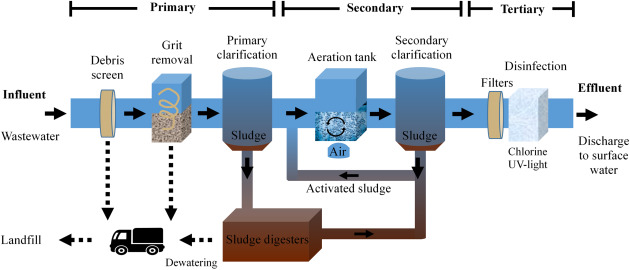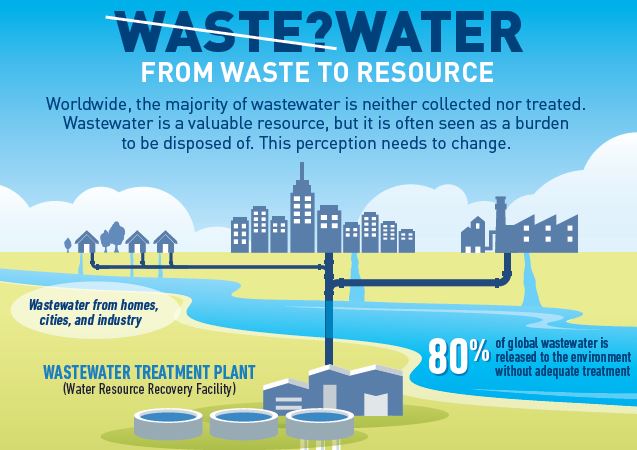Understanding Wastewater Therapy Processes and Their Ecological Effect
The complexities of wastewater therapy processes play a crucial duty in mitigating ecological difficulties associated with water pollution. Each phase, from initial to innovative therapies, is created to resolve certain pollutants, inevitably safeguarding both public health and wellness and marine communities. Nevertheless, despite technical innovations in therapy performance, substantial challenges continue, consisting of the administration of residual pollutants and the effects of nutrient runoff. As we discover the complexities of these processes, it comes to be necessary to doubt exactly how much existing methods can advance to satisfy the expanding demands of sustainability and ecological conservation.
Overview of Wastewater Therapy
Exactly how is wastewater changed into a secure source for the environment? Wastewater therapy is an important process designed to eliminate contaminants from made use of water, consequently securing public health and wellness and securing environments. This process begins with the collection of wastewater from household, industrial, and business sources, which is after that guided to therapy centers.
At these facilities, numerous physical, chemical, and biological methods are utilized to deal with the wastewater. Subsequently, organic treatments, such as turned on sludge procedures, use microorganisms to damage down organic issue.
The dealt with effluent can be securely discharged right into all-natural water bodies or reused for irrigation and industrial objectives, promoting source preservation. Furthermore, the therapy procedure generates biosolids, which can be repurposed as fertilizers or dirt changes, further improving sustainability.
Stages of Therapy Procedures
The wastewater treatment process normally contains 3 primary phases: preliminary, primary, and additional treatment. Each phase serves a distinct role in minimizing the toxin tons and making sure the effluent fulfills environmental standards before discharge.

The primary treatment phase focuses on the physical separation of suspended solids from the wastewater. Via sedimentation, larger particles resolve at the base of sedimentation containers, forming sludge, while lighter materials, such as oils and greases, float to the surface and are skimmed off. This process substantially decreases the organic and inorganic tons in the wastewater.
Secondary treatment is a biological process intended at additional minimizing the concentration of natural matter. This phase is essential for achieving the required biochemical oxygen demand (FIGURE) decrease, ultimately leading to cleaner effluent ready for discharge or more treatment.

Advanced Treatment Technologies
Complying with the additional treatment procedures, progressed treatment modern technologies play an essential duty in additional enhancing the quality of dealt with wastewater. These innovations are designed to eliminate residual pollutants that are not efficiently gotten rid of during main and secondary therapies, making certain the link effluent meets stringent governing requirements.
Among the commonly used innovative therapy approaches are membrane filtration, reverse osmosis, and progressed oxidation procedures. Membrane filtration, including microfiltration and ultrafiltration, works in separating fine particles, microorganisms, and colloids from the water (Wastewater). Reverse osmosis utilizes semi-permeable membrane layers to remove dissolved solids, leading to high-grade water suitable for numerous applications
Advanced oxidation procedures (AOPs) utilize strong oxidants to break down natural toxins, consisting of pharmaceuticals and individual care items that are immune to conventional therapy. These techniques enhance the biodegradability of intricate substances, facilitating their elimination.
Another considerable innovation is making use of organic nutrient removal procedures, which particularly target nitrogen and phosphorus, avoiding eutrophication in receiving water bodies. Generally, innovative treatment technologies are vital for attaining greater levels of purification, advertising water reuse, and protecting public health while attending to the obstacles associated with wastewater administration.
Ecological Benefits of Treatment
Numerous ecological benefits occur from reliable wastewater treatment procedures that add to ecosystem health and sustainability. Largely, these procedures significantly reduce the release of harmful contaminants right into all-natural water bodies, which assists maintain water communities. By removing impurities such as hefty steels, nutrients, and microorganisms, dealt with wastewater minimizes the threat of waterborne illness and advertises biodiversity in aquatic environments.
Furthermore, wastewater therapy centers commonly use sophisticated technologies that enable water recycling and reuse. This practice not only preserves fresh water sources but additionally decreases the need on all-natural water materials. Improved nutrient elimination from wastewater can also stop eutrophication, a process that causes algal blossoms and succeeding oxygen depletion in marine systems.
Furthermore, effective therapy processes can reduce greenhouse gas emissions, specifically methane and nitrous oxide, web link which are often launched during neglected wastewater disintegration. By catching and making use of read biogas from anaerobic digesters, centers can convert waste into renewable resource, consequently adding to a decrease in nonrenewable fuel source dependency.
Challenges and Future Trends
While the ecological advantages of wastewater therapy are clear, numerous challenges linger that prevent optimal outcomes in this area. One significant issue is maturing framework, which often leads to inadequacies and raised operational expenses - Wastewater. Lots of treatment plants were created years earlier, and their abilities do not align with contemporary needs, that include more stringent regulatory requirements and higher volumes of wastewater due to urbanization

Looking in advance, there is an expanding emphasis on resource recuperation and circular economy principles within wastewater treatment. Innovations such as anaerobic digestion, which can generate biogas, and advanced filtering modern technologies are acquiring grip. These techniques not just boost therapy efficiency yet likewise advertise sustainability.
Eventually, dealing with these challenges needs collaboration amongst stakeholders, investment in technology, and a dedication to continuous study. By welcoming these fads, the wastewater treatment market can progress to meet the demands of a changing atmosphere and society.
Verdict
To conclude, wastewater treatment processes play an essential role in improving ecological quality and public health and wellness. The multi-stage therapy structure, paired with innovative technologies, effectively reduces pollution and promotes lasting water monitoring. By dealing with residual contaminants and reducing nutrition overflow, these processes contribute to the preservation of marine ecosystems and the decrease of greenhouse gas exhausts. Proceeded improvements and adaptations in therapy methods will be necessary for overcoming arising challenges and ensuring the sustainability of natural deposits (Wastewater).